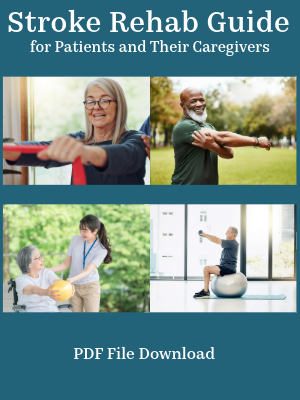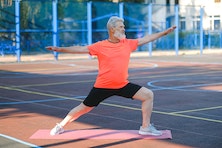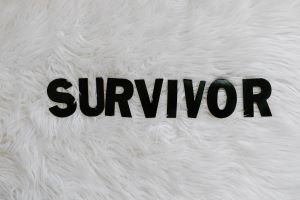Dysarthria
Medically reviewed by Karen Murray, OT, CHT, CSRS - written by Stroke-rehab.com
Dysarthria can occur after stroke due to weakness or paralysis in the muscles controlling mouth and facial movements or the respiratory system. Symptoms may include slurred speech, abnormal rate of speech (slow or fast), speaking softly, impaired pitch, impaired rhythm of speech, impaired quality of speech, drooling, and decreased mouth movements. Speech impairment can make it difficult to communicate effectively and may affect interaction with family and friends, especially in social situations.
Dysarthria Treatment
Treatment techniques for dysarthric patients may aim at slowing the rate of speech, improving breath support to increase volume of speech, strengthening face and mouth musculature, improving mouth/tongue movement, teaching adaptive strategies, and using alternative means of communication such as alphabet boards or computer devices.
A speech language pathologist (SLP) can help a stroke victim overcome speech difficulties or learn to use alternative methods of communication if needed. Some of the techniques used by speech therapists for dysarthria treatment include:
Improving Oral Muscle Strength
- Tongue Movements In/Out, Up/Down, Side to Side
- Lip Puckering: Pucker the lips as if you're going to kiss someone. Hold the pucker for a few seconds, then relax. This exercise helps strengthen the orbicularis oris muscle, which is important for lip closure.
- Cheek Puffing: Close your mouth and puff up the cheeks, holding the air inside for a few seconds. Then, slowly release the air. This exercise targets the buccinator muscles, which aid in cheek movement and control.
- Smiles & Frowns
- Tongue to Nose
These are just a few muscle strengthening exercises used. Consult with a speech therapist for appropriate exercise for your situation.
Articulation Exercises
These are some of the articulation exercises one may encounter during therapy for dysarthria:
- Isolated Sound Repetition: Patients practice saying individual speech sounds repeatedly
- Sound Combinations (e.g., "ba," "pa," "ma")
- Minimal Pairs Practice: Minimal pairs are words that differ by only one sound, such as "cat" and "bat." Practicing these pairs helps patients discriminate between similar sounds.
- Targeted Words: The therapist selects words that contain the patient's target speech sounds to help the patient become more comfortable with challenging sounds.
- Sentence-Level Exercises: Using sentences that contain the target sounds helps patients integrate articulation skills into more complex speech patterns.
- Reading Aloud: Patients read passages aloud, focusing on proper articulation of target sounds.
- Tongue Twisters: Challenging patients to articulate difficult sound sequences rapidly.
Prosody Training
Prosody refers to the way changes in the voice are used to communicate. Examples of prosody include higher or lower pitch, stress on certain words, speed, volume of speech, and making speech sound like a rhythm. Prosody helps reflect emotion and show meaning in what we say. Some examples of prosody exercises include
- Saying phrases with different emotional tones such as excitement, sadness, anger, and surprise. This exercise helps practice adjusting pitch and tone to convey various emotions
- Question and Statement Practice: Have the person alternate between asking questions and making statements while focusing on appropriate intonation patterns. For example, the statement "The dogs are hungry." would sound different and have different meaning than if used as a question, "The dogs are hungry?"
- Emphasis and Stress: Provide a sentence and ask the individual to emphasize different words to change the meaning.
Breathing Exercises
Breathing exercises that SLPs may use include diaphragmatic breathing, segmental breathing, prolonged exhalation, and breath support exercises during speech to name a few. Since each stroke patient will have different respiratory capacities and precautions, it is best to consult with a SLP to determine which exercises are appropriate.
Find a SLP (Speech Therapist)
One can search for a speech language pathologist also frequently referred to as a speech therapist at the following link:
Tips for Communicating
Stroke patients with slurred speech can try the following techniques to improve communication with others:
- Speak slowly and loudly
- Pause frequently
- Ask the listener if they understand you
- Limit conversation when you are tired
- Use body language to help compensate
Tips for Caregivers
Caregivers can use the following techniques to help them better understand the stroke patient with impaired articulation:
- Pay attention to the speaker and look at them while they talk
- Reduce distractions and background noise
- Let the speaker know when you have difficulty understanding
- Ask Yes/No questions rather than open ended questions when having difficulty understanding
- If you can't understand what is being said, ask the patient to write the message if able
Get Our Stroke Rehab Guide

Our stroke rehab guide is designed specifically for patients and caregivers. It's in pdf format and can be immediately downloaded. It includes about
- Stroke Definition & Causes
- Stroke Treatment
- Rehabilitation Information for Physical, Occupational and Speech Therapy
- Exercise pictures
- Q&A from patients and caregivers
- Adaptive Equipment & Techniques
- How to Prevent Another Stroke & More!
- Home
- Slurred Speech
Medical Disclaimer: All information on this website is for informational purposes only. This website does not provide medical advice or treatment. Always seek the advice of your physician or other healthcare provider before undertaking a new healthcare or exercise regimen. Never disregard professional medical advice or delay seeking medical treatment because of something you have read on this website. See the disclaimer page for full information.
















